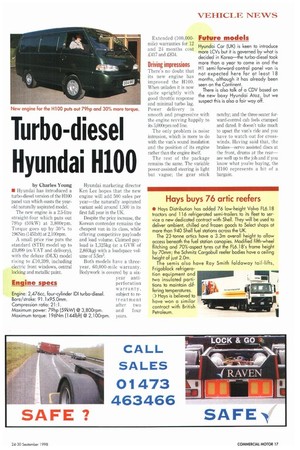Turbo-diesel Hyundai H100
Page 19

If you've noticed an error in this article please click here to report it so we can fix it.
by Charles Young • flyundai has introduced a turbo-diesel version of the H100 panel van which ousts the yearold naturally aspirated model.
The new engine is a 2.5-litre straight-four which puts out 79hp (59kW) at 3,800rpm. Torque goes up by 30% to 196Nm (1451bft) at 2,100rpm.
A small price rise puts the standard (STD) model up to 19,899 (ex-VAT and delivery), with the deluxe (DLX) model rising to £10,399, including electric front windows, central locking and metallic paint. Hyundai marketing director Ken Lee hopes that the new engine will add 500 sales per year—the naturally aspirated variant sold around 1,500 in its first full year in the UK.
Despite the price increase, the Korean contender remains the cheapest van in its class, while offering competitive payloads and load volume. Claimed payload is 1,325kg (at a GVW of 2,860kg) with a loadspace volume of 5.5m3.
Both models have a threeyear, 60,000-mile warranty. Bodywork is covered by a sixyear antiperforation warranty, subject to retreatment after two and four years.
Extended (100,000mile) warranties for 12 and 24 months cost 1417 and £834.
Driving impressions
There's no doubt that its new engine has improved the H100. When unladen it is now quite sprightly with good throttle response and minimal turbo lag. Power delivery is smooth and progressive with the engine revving happily to its 5,000rpm red line.
The only problem is noise intrusion, which is more to do with the van's sound insulation and the position of its engine rather than the engine The rest of the package remains the same, The variable power-assisted steering is light but vague; the gear stick notchy; and the three-seater forward-control cab feels cramped and dated. It doesn't take much to upset the van's ride and you have to watch out for crosswinds. Having said that, the brakes—servo assisted discs at the front, drums at the rear— are well up to the job and if you know what you're buying, the 1-1100 represents a bit of a bargain.
Future models
Hyundai Car (UK) is keen to introduce more LCVs but it is governed by what is decided in Korea—the turbo-diesel took more than a year to come in and the HI semi-forward-control panel van is not expected here for at least 18 months, although it has already been seen on the Continent.
There is also talk of a CDV based on the new boxy Hyundai Atoz, but we suspect this is also a fair way off.
Engine specs
Engine: 2,476cc, four-cylinder 1D1 turbo-diesel. Bore/stroke: 91.1x95.0mm.
Compression ratio: 21:1.
Maximum power: 79hp (59kW) @ 3,800rpm. Maximum torque: 196Nm (144lbft) @ 2,10Orpm.




























































































































